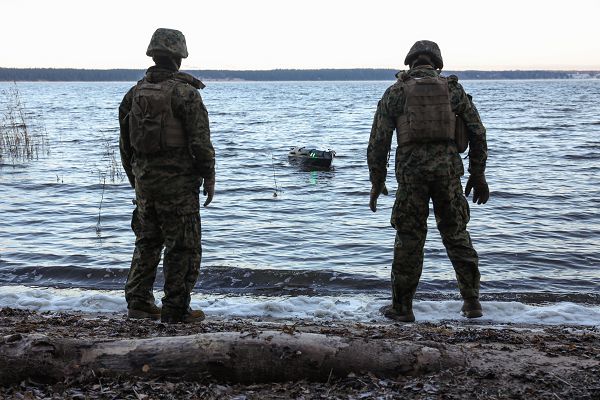
Syndalen, Finland. (November 17, 2023): While “Kamikaze” drones and Predator unmanned aircraft have dominated the headlines, another type of autonomous system is being developed by the Navy that is literally beneath the waves. In conjunction with commercial scientists, this aggressive program will develop and build unmanned underwater vehicles to perform a wide range of shallow water missions. In this photo by Corporal Mary Kohlmann, Corporals Gabriel Hawks and William Morris with Combat Logistics Battalion 6, Combat Logistics Regiment 2, 2nd Marine Logistics Group, prepare to retrieve the “AMY”, an unmanned surface vehicle during a series of tests to experiment with its capabilities. The AMY is a lightweight (145 pounds) autonomously operated platform that can handle missions ranging from delivering lifesaving supplies to scanning for mines and much more.
Working with Arizona-based Hydronalix Corporation, the Marine Corps is experimenting with equipping these underwater drones with various x-band radars, side scan sonars, and even a high-speed bandwidth connection via satellite for communications and control. Powered by twin electric jet drives, the AMY can reach a top speed of 18 miles per hour, even in rough surf conditions, while searching for mines or obtaining measurements such as depth and water temperature.
The goal is to use the AMY to send vital supplies ashore especially when helicopters cannot. A Marine could load a lifesaving cargo of plasma and morphine, for example, then select a destination on shore and dispatch the AMY directly to that location. The system requires no central ground station and the AMY can be programed to return to be recovered, reloaded, and sent off again.
A side benefit of the Navy’s efforts is how useful these technologies will be in a humanitarian crisis. Unmanned platforms can reach isolated areas to deliver water, medicine, and food after a natural disaster that may be inaccessible by any other means.
While drones in the sky seem to be all the rage right now, the Navy is quietly creating some unmanned stars of their own.


